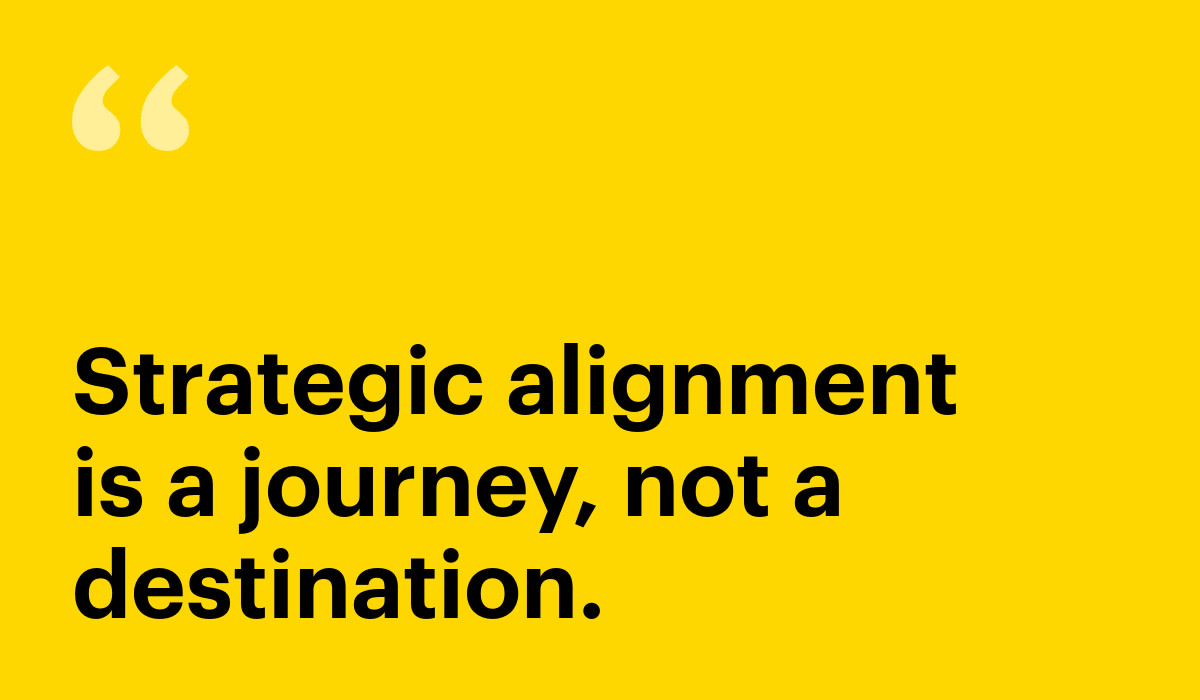4 Ways People Analytics Helps Enterprise Leaders Create Strategic Alignment
Strategic alignment is a pivotal success factor for your organization. Find out how people analytics enables it.

Strategic alignment—or rather, lack of—is the major culprit for things going wrong, making building alignment a pivotal success factor for today’s business leaders. As many as 90% of enterprise strategic initiatives fail. In a turbulent and competitive environment, failure is a cost few organizations can afford.
What is strategic alignment?
Strategic alignment is the process of aligning all stakeholders, internal and external, so that all are focused and committed to achieving a shared organizational vision. Jonathan Trevor, Associate Professor of Management Practice at the University of Oxford’s Saïd Business School and Barry Varcoe, Associate Fellow at the same, define strategic alignment this way: “strategic alignment, for us, means that all elements of a business […] are arranged in such a way as to best support the fulfillment of its long-term purpose.”
They point out how strategic alignment hinges on a “tightly managed enterprise value chain”—and ensuring strategic alignment means systematically interrogating each element. This chain is “only as strong as its weakest link” because its components are deeply interdependent: strategy fulfills purpose; organizational capability supports strategy; resource architecture enables organizational capability; management systems determine resource performance.
How people analytics affects strategic alignment
Representing up to 60% of total business costs and generating 2x–6x revenue compared to their costs, your human resources—your people—are a crucial piece of the puzzle. Strategic alignment hinges on connection, coherence, and clarity: the better you understand the complexity in your enterprise, the better you can leverage it.
People analytics is invaluable to building strategic alignment in four major ways:
Clarify organizational dynamics and build a strategically-aligned workforce
Create consensus by dissolving siloes and powering aligned decision-making
Align talent acquisition and L&D initiatives to evolving strategic needs
Build an inclusive culture that empowers everyone to fulfil your strategic goals
1. Clarify organizational dynamics and build a strategically-aligned workforce
An organization’s resource architecture is fundamental to strategic alignment. That is, the configuration of people, culture, technology, and processes that determine whether work happens in a way that’s aligned to your strategy.
This might sound simple. But complexity is a major barrier, muddying visibility and disguising unhelpful underlying dynamics.
Robust, real-time people analytics can bring clarity. Agile workforce planning empowers business leaders to understand whether you’ve got the right skills mix to deliver your goals, highlights capability gaps, and steers thinking around best-next steps.
This is especially critical during times of turbulence, when strategic direction often evolves fast. To keep pace with change, business leaders need to close the gap between strategy and execution.
2. Create consensus by dissolving siloes and powering aligned everyday decision-making
Surfacing the undercurrents of misalignment is important. Innosight’s Bernard Kümmerli and Scott Anthony talk about how leadership teams are often misaligned on strategy despite superficial agreement. They emphasize the need to actively build consensus by ensuring everyone’s voice is heard.
This need for consensus doesn’t only extend to the senior leadership team. Enterprise independencies mean there’s a need for consensus across every function, in every territory, at every level. One that becomes exponentially harder the more complex the organization.
For true alignment, you need every employee to understand the part they play in the whole, and be productive and engaged in service of your strategic goals. Individual managers must be empowered to understand and act if that’s not happening. Strategic alignment can’t be separated from everyday decision-making.
Empowering daily decision-makers has always been one of the major benefits of people analytics. So much so that 39% of respondents to a recent Visier survey identified democratizing data as their biggest opportunity area.
Mature people analytics capability empowers business unit and department leaders to maintain a clear line of sight over their teams. This ensures strategic alignment on an individual and team level. If winning market share from competitors through a stronger sales force is a priority, for example, your sales leaders need to optimize the salesforce, territories, quotas, and incentives accordingly.

3. Align talent acquisition and L&D initiatives to evolving strategic needs
Strategic alignment is a journey, not a destination. As strategy evolves—that is, the series of choices you make around how best to achieve your goals—so must every subsequent stage in the value chain.
In practice, this means the skills and capabilities your organization needs change constantly. That has implications for both talent acquisition and development.
Talent acquisition leaders need to understand which attributes create long-term high-performing employees and act faster to bring them into the business.
Equally, L&D leaders need to build effective learning programs that align to strategic direction. This matters at every level but becomes especially important for leaders. Gartner predicts more than 40% of leadership roles will be significantly different within five years. This puts pressure on L&D to effectively spot and close skills gaps or risk a widening skills vacuum.
People analytics is powerful on both fronts, empowering results-driven recruitment and learning programs that drive strategy forwards.
4. Build a diverse and inclusive culture that empowers everyone to fulfill your strategic goals
Having the right people in the right places to support strategy means little unless those people are also empowered to give their best. Diversity and inclusion is one of your most robust levers to that end, especially as D&I becomes increasingly non-negotiable for employees.
It’s not just that diverse companies outperform their peers—although we’ve known for years that they do. It’s that the tide has turned, and employees are voting with their feet when organizations don’t act fast or emphatically enough to create change.
D&I is becoming for many enterprises a major gatekeeper to successful strategy. A revolving door of people slows progress, hurts morale, and undermines continuity.
People analytics drives proven D&I progress across crucial areas such as recruitment and onboarding, career pathing, reward and recognition, training and development, and health and wellbeing. Rather than a gatekeeper, D&I could be the pivotal factor for success.
Strategic alignment isn’t just a happy accident
Strategic alignment isn’t a happy accident, but an intentional decision backed by considerable thought and resources.
People analytics are a critical piece of the puzzle, providing comprehensive real-time data that illuminates hidden dynamics, surfaces underlying issues, and disentangles the lines of accountability. To align your people resources to best support your strategic goals.
The bottom line? You need to really, really see your employees. Here’s how. Visier


